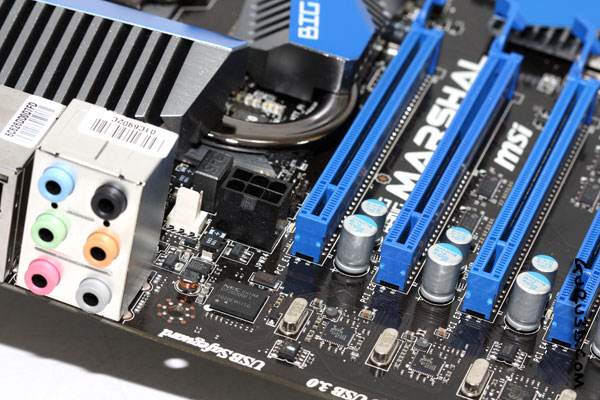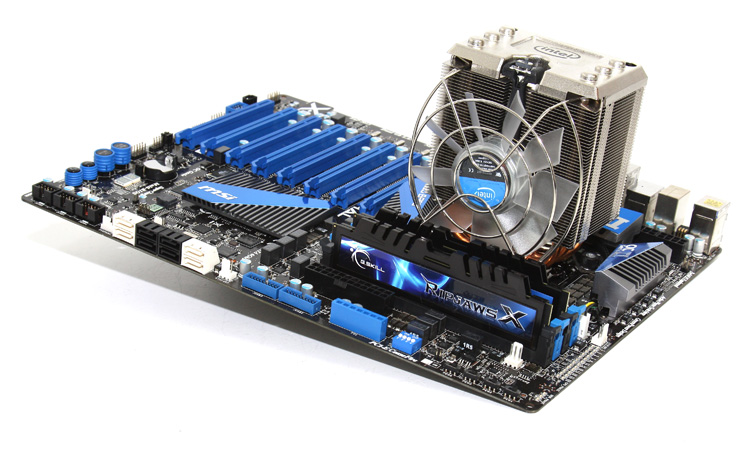Product Gallery

Of course on many locations on the board there is low level connectivity like extra USB 2.0, audio headers and so on. MSI also implemented a dual-BIOS, and calls this multi-BIOS. it is equipped with a auto-backup system that can recover the system and apply you last previous good boot, a really nice failsafe, switch able with a button actually.
Let's zoom in to the right:

Four buttons here, power on/off, reset and MSI's OC Genie II that allows users to overclock the CPU by simply hitting a button placed on the motherboard itself, it takes merely a few seconds. The automated overclock is actually pretty significant as enabling the OC Genie resulted into a clock frequency of 4200 MHz on out Core i7 2500K/2600K processor.
The Multi-BIOS button once pressed will make the motherboard switch towards the secondary failsafe BIOS. Of course switch when powered down only. Audio is handled by Realtek's 892 codec allowing 8 channels of audio, pretty much the standard norm these days on motherboards. We would like to see some more development done on the audio side of motherboards. Added is a X-Fi software layer that allows EAX5 though.

Slot connectivity wise you'll spot eight PCI Express x16 slots, an Lucid LT22102 provides the additional PCIe bandwidth needed. However the slots are limited as the motherboard needs way more PCie lanes to become fully operational, here's the breakdown:
-
PCIE 1 - supports up- to x16 speed when PCI 3 is empty
-
PCIE 2 - supports up- to x1 speed
-
PCIE 3 - supports up- to x8 speed
-
PCIE 4 - supports up- to x1 speed
-
PCIE 5 - supports up- to x16 speed when PCI 7 is empty
-
PCIE 6 - supports up- to x1 speed
-
PCIE 7 - supports up- to x8 speed
-
PCIE 8 - supports up- to x1 speed
So out of the eight mechanical slots four are x1 only, that's just silly. Slot 1 and 5 should be used in 2-way multi-GPU mode and with 32x lanes available up-to four cards can be used over PCIE 1, 3, 5 and 7.

Located next to the first PCIe slot we spot a 6-pin power header. If you would like to add a little more amperage on the PCie slots then you can connect the PSU here, which can help a little in overall stability.
Below it, you'll find the third NEC USB 3.0 controller IC.

Above you can see the OC Dashboard control POD, you connect it to the motherboard and it will allow you top overclock and monitor all kinds of variables.
The video above was taken with the Big bang Trinergy, same concept, and similar device. So we used the same video for demonstration purposes. The device allows for real-time statistics but also overclocking. You can tweak voltages on all primary parts and increase the base clock. It's a bit of a gadget granted -- but a very nice one.
The video is of poor quality as I had setup the camera improperly as I later found out -- apologies for that -- but you'll get the generic idea on how handy the OC Dashboard actually is.

As you can understand by now, the motherboard is going to be very complete and competitive with all that CrossfireX, SLI, USB3, SATA3 (6G) and RAID support. On RAID by the way, SATA 1 to 6 support RAID 0/1/5/10 through the Intel matrix raid controller. SATA 7 and 8 can be placed in RAID 0/1 by way of the Marvel controller.
So yeah the board has many features and a hosts other unusual features alongside the UEFI (GUI BIOS), which MSI labels Click BIOS interface. But let's startup some actual tests and see how well the motherboard performs in a real-world configuration.
